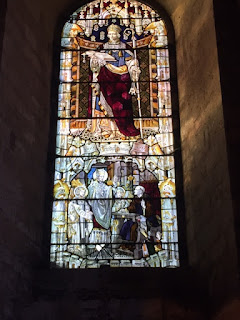We finished our work early on Thursday January 17th, so we decided to see one of the local landmarks here in Selby.
The Abbey of Selby
Between 1069 and 1535 Selby Abbey was a huge, rich, Benedictine monastery, complete with chapel, cloisters, stables, brew house, kitchen, workshops, dormitory, cellars, barns and infirmary, all surrounded by high walls with a large gateway.
Building of this amazing complex began shortly after the Norman conquest in the mid 11th century with a monk called Benoit (Benedict), as he had a vision of the Abbey and set out to build it in Selby.
There was a small community of Anglo-Vikings living on the high ground here beside the River Ouse, and building of the Abbey began in 1069 AD.
It took 130 yrs. to build the Abbey and in 1535, when King Henry VIII confiscated the religious houses in England including Selby Abbey.
The Abbey proper and Graves are all that are left of the original complex, but this building is amazing, inside and out.
Due to neglect the upper tower collapsed into the choir and south transept (entry) in 1690. The tower was repaired and rebuilt in 1702 but it was much later, after another catastrophe, before the other repairs were made.
In October 1906 there was a fire that destroyed much of the old roof timbers and the bells of the tower came crashing down. Charred beams were all that was left of the roof.
Believe it or not, there was some good news after the fire. The ancient stained glass windows of the Chancel or Jesse window that dates back to 1330 AD, had been saved by the quick thinking of fireman who kept water on them and other windows during the fire.
The Restoration began within a year after the fire and was completed within 3 years, including the South Transept which had collapsed over 200 yrs. earlier.
The above window is a newer window depicting the crucifixion.
Some of these windows are very old, from the early 14th century, and some are as new as the 1960's. But they are all amazing!
Above is the grave slab of John Barwic who was Abbot here from 1522-1526.
Below is the window of Abbot Benedict.
I believe this might be the window of the parable of the Prodigal Son.
Looking from the Nave through the very intricately carved screen into the Chancel.
Below is a newer window that was put in during the restoration, it depicts King Edward VII and Queen Alexandra.
The ceiling of the Abbey.
Below is the St. Germain Window, rebuilt during the 1907 restoration. Only the very bottom corner has the original medieval glass.
This window is made up of stained glass sections salvaged from other windows and dating to as early as the 1400s AD.
The choir screen.
I believe this is the resurrection window, or the window that depicts heaven.
Another window containing pieces of other windows.
The Alter.
And we could see the beautiful Washington Window which is supposed to be the inspiration for the Stars and Stripes of the United States Flag.
The shield on the above window with the stars and stripes is the shield of the Washington Family.
A quilted depiction of the Washington Shield.
One of the information plaques which tells of the Washington Window, the Lepers Squint and other features.
Another view of the Alter in the Chancel.
Looking from the Chancel back to the Nave.
The beautiful and completely intact Jesse Window. This window is from the 1330s AD and depicts the lineage of Jesse, including Joseph, Mary and Jesus.
This has been one of the most incredible churches I have ever visited. If you ever get the opportunity you must come and see it.
⛪⛪⛪⛪⛪
⛪⛪⛪⛪⛪
On Saturday we went back into York and thought we'd check out the York Minster. It was quite crowded when we got there and they wanted an £11.00 ($14.00) entry fee. We decided to come back another day, but we did get these photos.
The Nave
In the welcome pamphlet of the York Minster it tells us "Within 200 yrs. of the birth, death and resurrection of Jesus, his followers began to gather on this spot."
A Minster or "Mynster"was an Anglo-Saxon word for missionary church. A building was begun in 671 but was destroyed by the Normans. Work began on the Norman Cathedral in 1080. It was completed in stages, the Nave completed in 1338, the Central Tower was completed in 1465 and the Minster was finally consecrated in 1472.

































































No comments:
Post a Comment